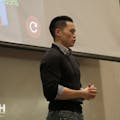Did you take your pill today? That is a simple question for which there are many devices on the market to help remind patients to take their medication, varying in complexity from timers to automatic dispensers. Medication compliance (diligently taking one's medicine as prescribed) is a major concern because failure to do so is a leading cause of preventable illnesses, and emergency room visits.
This project allows for modular and incremental system expansion to incorporate new technologies and facilitate participation in health monitoring systems with HIPAA compliance to ensure the patient's privacy while giving the freedom to live at home with minimally intrusive activity monitoring.
Ubiquitous Computing
Ubicomp (Ubiquitous or Pervasive computing) is no longer science fiction. Micro controllers, embedded systems, system-on-chip, commodity wireless systems (cellular phones, WAN, PAN), all give the building blocks for Sensor Networks in the home.
Pervasive computing is the trend towards increasingly ubiquitous (another name for the movement is ubiquitous computing), connected computing devices in the environment, a trend being brought about by a convergence of advanced electronic - and particularly, wireless - technologies and the Internet.
Pervasive computing devices are not personal computers as we tend to think of them, but very tiny - even invisible - devices, either mobile or embedded in almost any type of object imaginable, including cars, tools, appliances, clothing and various consumer goods - all communicating through increasingly interconnected networks.
Among the emerging technologies expected to prevail in the pervasive computing environment of the future are wearable computers, smart homes and smart buildings. Pervasive computing researchers aim to understand how to create systems that are pervasively and unobtrusively embedded in the environment, completely connected, intuitive, effortlessly portable, and constantly available, that are of social value.
- Source: Q. Jones, "Pervasive Computing CIS686 course description", 2006, http://modiin.njit.edu/courses.html.
Ambitious home health systems seek to combine "smart homes" with tele-medicine in order to better react to the patient's needs and for more accurate inferences of the patient's activity. Placing sensors in slippers and shoes reports if they're getting exercise, giving timely information while avoiding personal RFID tags when possible (such as living alone). Such monitoring will semi-automate required elder care reports such as ADL (activities of daily living) and actually increases privacy with the 'invisible man' model (like in the movies, the invisible man is inferred by the objects he touches, moves and manipulates) [10], [11]. This illustration shows how medicine monitoring is just one part of the system.
- Source: P. Ross, "Managing Care Through The Air", IEEE Spectrum, vol 41, number 12, pp. 26-31, December 2004.
There are many dystopian visions of a future where technology alienates and dehumanizes people, such as the movies Metropolis, Modern Times, Minority Report and Gattaca. Engineering has always been a human endeavor and most professional societies (such as the IEEE, ACM, Order of the Engineer) have rules of ethics to protect society from technological abuse. This relates to the topic because privacy and ethics must be part of the design and implementation from the start, not retrofitted or left for later. It is an obligation of the engineer.
Telemedicine
The Citizen Health System is a proposed monitoring system using wireless monitoring.
Health delivery practices are shifting towards home care. The reasons are the better possibilities for managing chronic care, controlling health delivery costs, increasing quality of life and quality of health services and the distinct possibility of predicting and thus avoiding serious complications. For the above goals to become routine, new telemedicine and information technology (IT) solutions need to be implemented and integrated in the health care delivery scene, and these solutions need to be assessed through evidence-based medicine in order to provide solid proof for their usefulness. Thus, the concept of contact or call centers has emerged as a new and viable reality in the field of IT for health and telemedicine.
In this paper we describe a generic contact center that was designed in the context of an EU funded IST for health project with acronym Citizen Health System (CHS). Since the generic contact center is composed of a number of modules, we shall concentrate on the modules dealing with the communication between the patient and the contact center using mobile telecommunications solutions.
We further elaborate on the development tools of such solutions, the interfacing problems we face, and on the means to convey information from and to the patient in an efficient and medically acceptable way. This application proves the usefulness of wireless technology in providing health care services all around the clock and everywhere the citizen is located, it proves the necessity for restructuring the medical knowledge for education delivery to the patient, and it shows the virtue of interactivity by means of using the limited, yet useful browsing capabilities of the wireless application protocol
- Source: N. Maglaveras, V. Koutkias, I. Chouvarda, D. Goulis, A. Avramides, D. Adamidis, G. Louri das, EA. Balas, "Home care delivery through the mobile telecommunications platform: the Citizen Health System (CHS) perspective," International Journal of Medical Informatics,†Volume 68,†Issue 3, pp. 99-111, Dec 18 2002.
Wireless monitoring of medication is one of the many inputs upon which such systems will depend.
Wrinkle works by letting the patient knows via push notification through Alexa when to take his medications at the doctor's specification. It also allows the doctor to actually monitor the way they are taking their medications.














Comments
Please log in or sign up to comment.